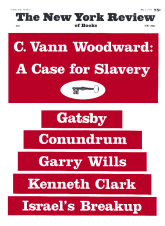In response to:
Stravinsky's Russian Letters from the February 21, 1974 issue
To the Editors:
In The New York Review of Books of February 21, 1974, Mr. Craft mentions my book Catherine Strawinsky, Album de Famille (published in 1973 by Boosey and Hawkes in London). He criticizes the choice of the photographs. The title of my book itself explains my choice and justifies the text, which had the aim of describing the family atmosphere in which my father lived a great part of his life.
Then Mr. Craft declares that Strawinsky conducted for the first time in public in Montreux. This is incorrect; it was only a private rehearsal which took place in Montreux at the Casino. By the way I was present. (For extra details of Chroniques de ma vie, by Igor Strawinsky, original edition, pp. 114 and 128.)
Mr. Craft declares as well that I wrongly attributed the title “Madrid” to a piece my father wrote for Pianola (this is also described in Chroniques de ma vie, pp. 150 and 151).
Concerning L’Histoire du Soldat I maintain that after the first stage performance of this work in Lausanne (September 29, 1918) there were no further stage performances of this work in its original shape for many years. It is evident that I was not refering to the concert performances or to the Suite for clarinette, violin, and piano as Mr. Craft mentions.
No one denies Mr. Craft’s competence in the musical domain but why does he criticize wrongly a book written by Igor Strawinsky’s own son? A book which in no way should disturb him, or does it?….
Théodore Strawinsky
Geneva, Switzerland
Robert Craft replies:
The first statement in Theodore Stravinsky’s final paragraph is flattering news indeed, and I am most grateful to him for conveying it to me. I only hope that this part of his letter is more accurate than the rest, for he even misquotes the title of his book. If it really were Catherine Stravinsky, Album de Famille, I would certainly not have objected to the comparatively low proportion of photographs that include Igor Stravinsky.
The rehearsal of the Symphony in E Flat that Theodore Stravinsky attended took place on April 1, 1914. Ernest Ansermet performed the work the following day, and with such success that he decided to repeat a movement from it in his next concert and to ask the composer to direct it. Stravinsky accepted, chose the Scherzo, and on April 16 (see NYR, February 21) made his first public appearance as a conductor. The Messager de Montreux reviewed the event on April 17, commenting on “les, vifs applaudissements qui saluerent la fin de chaque morceau,” as well as on Stravinsky’s own performance: “Cet artiste possède un talent de direction net et sobre, parfois même un peu froid.” But since the Chroniques de Ma Vie gives no report of the occasion, Theodore Stravinsky has looked no further.
The passage in the Chroniques to which Theodore refers does not refute my criticism of his use of “Madrid” as a title of the Etude for Pianola (1917). Etude is the name on the original perforated roll, on the program of the first performance, and in all of the composer’s correspondence. The music was not called “Madrid” before the orchestral arrangement of 1929.
Histoire du Soldat was never given again in its original “shape.” For one thing, Stravinsky recomposed the last dance before the next performance of the music (in 1920). Nor is it “evident” from Theodore Stravinsky’s context (“the first performance was to remain for years the only performance the work ever had”) that he “was not referring to the concert performances.” Besides, this ignores performances without music, such as the one that C.F. Ramuz presented in Zurich only a few weeks after the premiere. The Chroniques, in any case, is both incorrect and extremely vague about the early productions, even failing to mention that the Bauhaus performances (1923) were staged, and entirely overlooking what may well have been the most interesting one that the work has ever received, the Pirandello Theater’s in Rome.
Since a great many of Theodore Stravinsky’s inaccuracies are merely repetitions of those of his father, is it not time to admit that the Chroniques is an unreliable source? Concerning factual matters, Stravinsky seems hardly to have consulted his own documents while writing the book. Worse still, it is not always a valid guide to its author’s true feelings and circumstances. The explanation of the former is that Stravinsky was both more discreet and more diplomatic as a young man than as an old one—a reversal of the usual order of things. As for the latter, the descriptions of travel and other adventures in the second half of the book are no more than partly true—for the reason that Stravinsky usually had a companion, which he could not say in 1934, the time of writing. (See the current NYR for this story.) Surely Theodore Stravinsky must have access to programs, diaries, and correspondence with which to supplement that family gospel, the Chroniques.
This Issue
May 2, 1974



